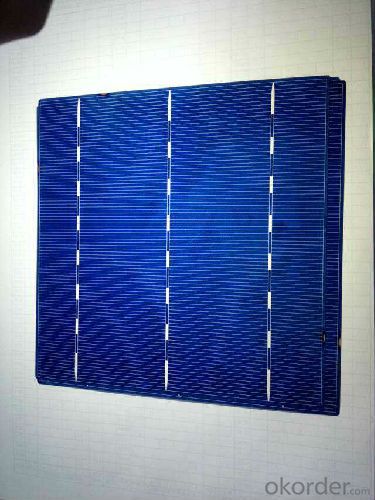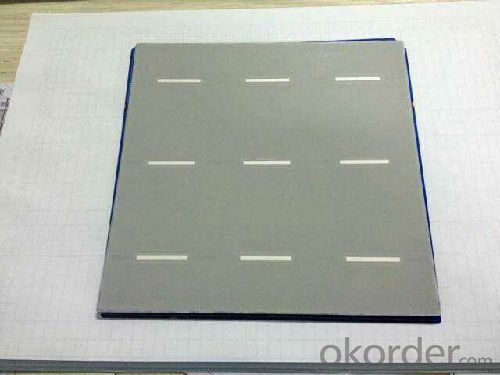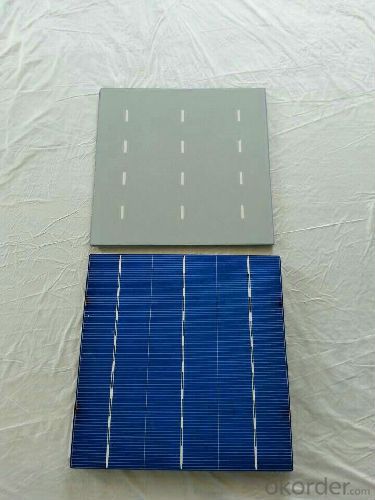Solar Cells Poly 3BB with Lower Price AB Grade
- Loading Port:
- Shanghai
- Payment Terms:
- TT or LC
- Min Order Qty:
- 30000 pc
- Supply Capability:
- 1000000 pc/month
OKorder Service Pledge
OKorder Financial Service
You Might Also Like
Electrical Characteristic
Efficiency (%) | Pmpp (W) | Umpp (V) | Impp (A) | Uoc (V) | Isc (A) | FF (%) |
17.25 | 4.197 | 0.524 | 7.992 | 0.62 | 8.458 | 80.03% |
17 | 4.137 | 0.524 | 7.876 | 0.619 | 8.353 | 80.01% |
16.75 | 4.076 | 0.522 | 7.81 | 0.617 | 8.286 | 79.73% |
16.5 | 4.015 | 0.518 | 7.746 | 0.613 | 8.215 | 79.73 |
16.25 | 3.955 | 0.515 | 7.683 | 0.61 | 8.144 | 79.61% |
16 | 3.894 | 0.512 | 7.613 | 0.608 | 8.075 | 79.31% |
15.75 | 3.833 | 0.51 | 7.534 | 0.605 | 8.058 | 78.62% |
15.5 | 3.772 | 0.508 | 7.453 | 0.604 | 8.02 | 77.87% |
15.25 | 3.771 | 0.505 | 7.35 | 0.604 | 9.997 | 76.83% |
15 | 3.65 | 0.503 | 7.271 | 0.604 | 7.989 | 75.64% |
14.5 | 3.529 | 0.499 | 7.067 | 0.604 | 7.988 | 73.14% |
14 | 3.407 | 0.499 | 6.833 | 0.604 | 7.833 | 72.01% |
Intensity Dependence
Intensity [W/m2] | Isc× [mA] | Voc× [mV] |
1000 | 1.00 | 1.000 |
900 | 0.90 | 0.989 |
500 | 0.50 | 0.963 |
300 | 0.30 | 0.939 |
200 | 0.20 | 0.920 |



Advantage Of Poly Solar Cell 156mm
1: High quality cell, Level A cell (14%—17.5%)
2.Dimensione:156*156mm Diagonal:200mm
3: Qualified certification: TUV,CE certification.
4: Warranty: five years for whole unit
Photovoltaic cells are made of special materials called semiconductors such as silicon, which is currently used most commonly. Basically, when light strikes the cell, a certain portion of it is absorbed within the semiconductor material. This means that the energy of the absorbed light is transferred to the semiconductor. The energy knocks electrons loose, allowing them to flow freely. The third generation of solar cells includes a number of thin-film technologies often described as emerging photovoltaics—most of them have not yet been commercially applied and are still in the research or development phase. Many use organic materials, often organometallic compounds as well as inorganic substances. Despite the fact that their efficiencies had been low and the stability of the absorber material was often too short for commercial applications, there is a lot of research invested into these technologies as they promise to achieve the goal of producing low-cost, high-efficiency solar cells.
- Q:What is the best way to deal with surplus solar cells abandoned after burning?
- It could be a very good resource to be used, but the technology needs to be more advanced to really deal with that.
- Q:Can solar cells be used for powering wildlife tracking devices?
- Yes, solar cells can be used for powering wildlife tracking devices. Solar cells are a reliable and sustainable source of energy that can effectively power small electronic devices, including wildlife tracking devices. They can harness sunlight and convert it into electrical energy, providing a continuous power supply for tracking devices in remote locations where other power sources may be limited or unavailable.
- Q:What do the solar cell suppliers provide once we purchase the order from the solar cells from them.
- The good solar cells suppliers do not only sell you the solar cells products, they also give you very useful suggestions to help you install it.
- Q:What is the working principle of a solar cell?
- The solar cell works in the way that use the sunshine as the resources to generate the power for us to use.
- Q:Can solar cells be used to power remote disaster response systems?
- Yes, solar cells can be used to power remote disaster response systems. Solar cells are a reliable and sustainable source of energy, especially in areas where access to electricity may be limited or disrupted due to natural disasters. By harnessing the sun's energy, solar cells can provide power for various critical systems such as communication equipment, lighting, medical devices, and water purification systems in remote disaster-stricken areas. This helps in facilitating efficient and effective disaster response efforts, enabling responders to provide crucial aid and support to affected communities.
- Q:Can solar cells be used in art installations?
- Yes, solar cells can be used in art installations. They can be integrated into various artistic designs and sculptures to generate renewable energy and add an innovative and sustainable element to the artwork.
- Q:Can solar cells be used for powering remote sensors?
- Yes, solar cells can be used to power remote sensors. Solar cells convert sunlight into electricity, making them ideal for remote locations where other power sources may be unavailable. By harnessing the sun's energy, solar cells can provide a reliable and sustainable power supply for remote sensors, ensuring their continuous operation without the need for frequent battery replacements or wired connections to the grid.
- Q:Can solar cells be used in remote areas with no grid access?
- Yes, solar cells can be used in remote areas with no grid access. Solar cells convert sunlight into electricity, making them an ideal solution for remote areas where traditional power grids are not accessible. These off-grid solar systems can provide a reliable and sustainable source of electricity for various applications such as lighting, charging small devices, and powering basic appliances. Additionally, advancements in battery storage technology allow excess energy generated during the day to be stored and used during the night, ensuring continuous power supply even in remote areas without grid access.
- Q:How many types of solar cells are now being used in real life?
- Generally, there are two types of solar cells, one is Monocrystalline silicon solar cells, the other is polycrystalline silicon solar cells
- Q:Can solar cells be used for powering desalination plants?
- Yes, solar cells can be used for powering desalination plants. Solar energy can be harnessed by solar cells to generate electricity, which can then be used to power the various components of a desalination plant, such as pumps and filtration systems. This allows for a sustainable and environmentally friendly approach to desalination, utilizing renewable energy sources to convert seawater into potable water.
1. Manufacturer Overview |
|
|---|---|
| Location | |
| Year Established | |
| Annual Output Value | |
| Main Markets | |
| Company Certifications | |
2. Manufacturer Certificates |
|
|---|---|
| a) Certification Name | |
| Range | |
| Reference | |
| Validity Period | |
3. Manufacturer Capability |
|
|---|---|
| a)Trade Capacity | |
| Nearest Port | |
| Export Percentage | |
| No.of Employees in Trade Department | |
| Language Spoken: | |
| b)Factory Information | |
| Factory Size: | |
| No. of Production Lines | |
| Contract Manufacturing | |
| Product Price Range | |
Send your message to us
Solar Cells Poly 3BB with Lower Price AB Grade
- Loading Port:
- Shanghai
- Payment Terms:
- TT or LC
- Min Order Qty:
- 30000 pc
- Supply Capability:
- 1000000 pc/month
OKorder Service Pledge
OKorder Financial Service
Similar products
New products
Hot products
Hot Searches
Related keywords



























